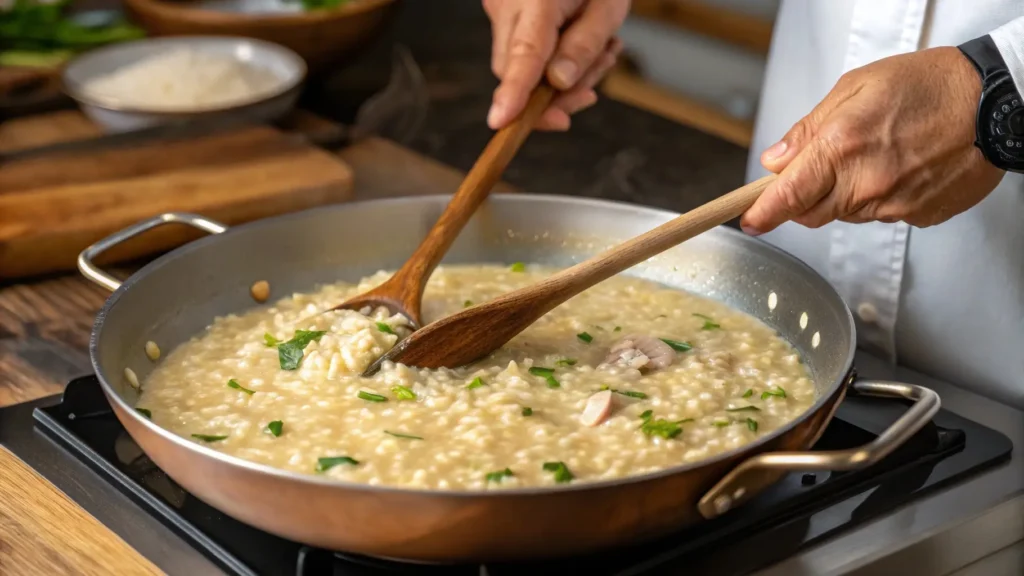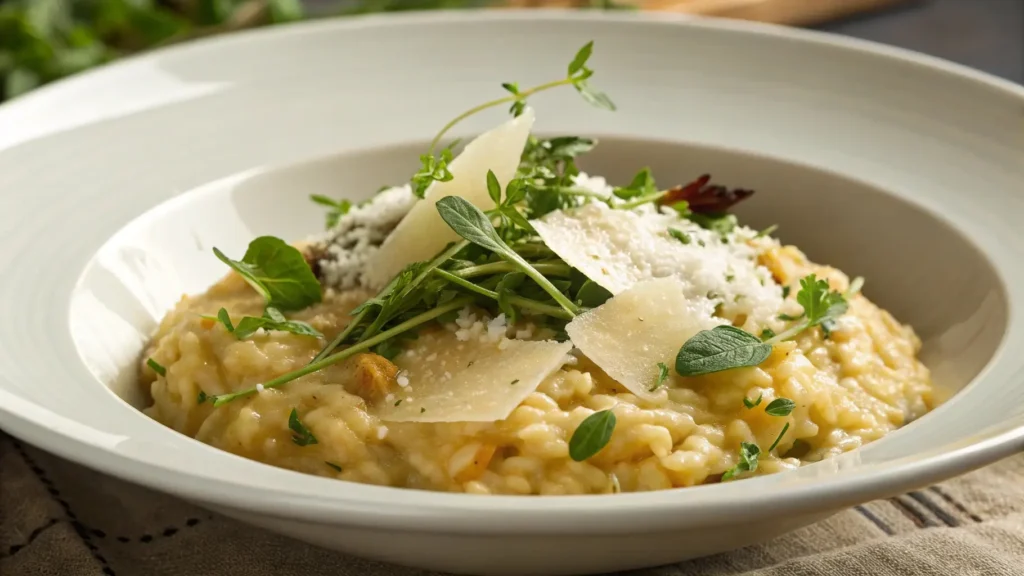What Is Risotto Rice? A Brief Overview
Risotto rice refers to a specific type of rice ideal for preparing risotto. It is characterized by its high starch content, which allows it to absorb liquids effectively while maintaining a creamy texture. Unlike regular long-grain rice, risotto rice has short, round grains that slowly release starch during cooking, giving risotto its signature creaminess.
This rice is known for its ability to absorb flavors, which is essential in a dish like risotto. Unlike other varieties, risotto rice needs to be cooked with constant stirring and gradual additions of broth or stock. This technique helps to achieve the perfect consistency – a balance between tender rice and a creamy, velvety sauce.
While risotto rice is traditionally used for risotto, its unique properties make it a versatile option for other dishes that require a creamy texture. In the next sections, we will explore the different types of risotto rice, their characteristics, and how to choose the best one for your dish.
Table of contents
Types of Risotto Rice: Arborio, Carnaroli, Vialone Nano, and More
When it comes to risotto rice, there are several varieties that stand out, each offering different textures and cooking properties. The most common types include Arborio, Carnaroli, and Vialone Nano.
- Arborio: This is the most widely available variety of risotto rice. It is plump, short-grained, and highly starchy, making it perfect for creating creamy risottos.
- Carnaroli: Known as the “king of risotto rice,” Carnaroli has slightly larger grains and higher starch content than Arborio. It tends to hold its shape better and creates an even creamier texture.
- Vialone Nano: This rice has a slightly more delicate grain and is prized for its ability to absorb liquid without becoming overly soft. It is often used in traditional Venetian risottos.

In addition to these, there are other varieties such as Baldo and Roma, each offering unique textures and flavors. Choosing the right risotto rice depends on your desired outcome, as each variety brings something different to the dish.
How to Choose the Best Risotto Rice for Your Dish
Selecting the best risotto rice depends on your personal preferences and the type of dish you’re preparing. The key is to choose a rice that will absorb liquids effectively while maintaining a firm texture.
For a creamy risotto with a smooth consistency, Arborio rice is a safe and popular choice. If you prefer a risotto with a firmer texture, Carnaroli rice may be the best option, as it retains its shape better during cooking. On the other hand, if you’re making a more delicate risotto, Vialone Nano is an excellent choice.
Consider the specific needs of your dish. For example, if you’re incorporating ingredients that require more liquid absorption, risotto rice like Carnaroli will help to balance the texture. Additionally, your recipe may recommend a particular variety, so it’s important to follow those guidelines.
Cooking Techniques: Mastering the Art of Risotto Preparation
Mastering the art of risotto preparation starts with understanding the basic cooking techniques. The key to creating a perfect risotto lies in the gradual addition of liquid and constant stirring. Here’s a quick overview of the process:
- Sauté the aromatics: Begin by sautéing onions, garlic, or shallots in a bit of butter or oil until soft.
- Toast the rice: Add the risotto rice to the pan and toast it for a minute or two to release its starch.
- Gradually add stock: Begin adding warm stock one ladleful at a time, stirring constantly. Wait until the liquid is mostly absorbed before adding more stock.
- Stir continuously: Stirring helps release the starch from the risotto rice, contributing to the dish’s creamy texture.
- Finish with butter and cheese: Once the rice is cooked al dente and creamy, finish with butter, Parmesan cheese, and seasoning to taste.

By following these steps, you’ll be able to create the perfect risotto every time. Remember, patience is key, as risotto requires time and attention to detail.
Classic Risotto Recipes to Try at Home
If you’re new to making risotto, starting with a classic recipe is a great way to get comfortable with the process. Some popular risotto recipes to try include:
- Mushroom Risotto: This hearty dish combines the earthy flavors of mushrooms with the creamy texture of risotto rice for a comforting meal.
- Seafood Risotto: A delightful combination of shrimp, scallops, and fish, this risotto is perfect for seafood lovers.
- Lemon Risotto: Light and refreshing, lemon risotto adds a zesty flavor to the creamy base, making it a perfect side dish for chicken or fish.

These classic recipes are easy to prepare and allow you to experiment with different ingredients while mastering the risotto technique. Whether you’re making a rich, creamy dish or a lighter, more refreshing one, risotto rice is the key to achieving the perfect texture.
Health Benefits and Nutritional Profile of Risotto Rice
Risotto rice offers several health benefits, making it a valuable addition to your diet. Although it is primarily composed of carbohydrates, it provides essential nutrients that can support a balanced diet.
- Good source of energy: As a high-carb food, risotto rice provides a steady source of energy.
- Rich in fiber: Some varieties of risotto rice, such as brown Arborio, contain more fiber, which can help with digestion and regulate blood sugar levels.
- Low in fat: Risotto rice is naturally low in fat, making it a suitable option for heart-healthy dishes.
- Contains vitamins and minerals: Risotto rice provides small amounts of B vitamins, such as niacin and thiamine, which are important for energy production and brain function.
However, it’s essential to balance risotto rice with vegetables, lean proteins, and healthy fats to create a nutritious and well-rounded meal.
Common Mistakes to Avoid When Cooking Risotto
While making risotto may seem simple, there are several common mistakes that can affect the dish’s quality. To ensure your risotto turns out perfectly every time, avoid these common pitfalls:
- Using the wrong rice: Not all rice is suitable for risotto. Always choose risotto rice varieties like Arborio or Carnaroli for the best results.
- Adding all the liquid at once: Adding too much liquid at once can lead to mushy risotto. Gradually add stock and stir to achieve the right consistency.
- Skipping the stirring: Stirring constantly is crucial to release the starch from the rice. Skipping this step will result in a less creamy texture.
- Overcooking the rice: Risotto should be cooked until the rice is tender yet firm to the bite (al dente). Overcooking can cause it to become mushy.
By avoiding these mistakes, you can make a perfect risotto every time.
Print
Creamy Risotto Rice Recipe
- Total Time: 40 minutes
- Yield: 4 servings
Description
Learn how to make the perfect creamy risotto using Arborio rice. This simple and delicious recipe is perfect for any occasion and can be customized with your favorite ingredients.
Ingredients
- 1 ½ cups Arborio rice
- 4 cups chicken or vegetable broth (warm)
- 1 small onion (finely chopped)
- 2 cloves garlic (minced)
- 2 tablespoons butter
- 2 tablespoons olive oil
- 1 cup freshly grated Parmesan cheese
- Salt and pepper to taste
- Fresh herbs (e.g., parsley) for garnish (optional)
Instructions
- In a large pan, heat olive oil and butter over medium heat. Add chopped onions and cook until soft, about 5 minutes.
- Add minced garlic and cook for 1 more minute until fragrant.
- Add Arborio rice to the pan, stirring to coat the grains with the oil and butter.
- Gradually add warm broth, one ladle at a time, stirring frequently until the liquid is absorbed before adding more broth.
- Continue adding the broth and stirring for about 20-25 minutes, until the rice is tender but al dente.
- Stir in the Parmesan cheese, then season with salt and pepper to taste.
- Serve immediately, garnished with fresh herbs if desired.
Notes
You can customize this recipe by adding vegetables, mushrooms, or protein like chicken or shrimp.
- Prep Time: 10 minutes
- Cook Time: 30 minutes
- Category: Main Course
- Method: Stovetop
- Cuisine: Italian
Nutrition
- Serving Size: 1 bowl
- Calories: 350 kcal
- Sugar: 2g
- Sodium: 650mg
- Fat: 18g
- Saturated Fat: 9g
- Unsaturated Fat: 6g
- Trans Fat: 0g
- Carbohydrates: 38g
- Fiber: 1g
- Protein: 8g
- Cholesterol: 30mg
Keywords: risotto rice, creamy risotto, Arborio rice recipe, easy risotto, Italian risotto, homemade risotto
Pairing Risotto with the Perfect Side Dishes
Pairing the right side dishes with risotto can elevate your meal and create a balanced dining experience. Since risotto rice dishes are rich and creamy, it’s essential to choose accompaniments that complement and contrast its texture and flavor. Here are a few tips to help you select the best side dishes for your risotto:
Light salads are always a fantastic choice when paired with risotto. A tangy vinaigrette with fresh greens, such as arugula, spinach, or mixed lettuce, adds a refreshing contrast to the creamy texture of risotto rice. You can also add ingredients like citrus, berries, or nuts for extra flavor and crunch.
Grilled vegetables, such as asparagus, zucchini, and bell peppers, are another great option. Their smoky, charred flavors balance the richness of the risotto. Roasted root vegetables, like carrots or sweet potatoes, also work well, offering earthy flavors that pair nicely with a variety of risottos.
If you’re serving a meat-based risotto, such as one with chicken consider pairing it with roasted meats. Grilled chicken breast or even tender lamb chops can be a perfect match, adding depth to your dish without overwhelming the risotto’s flavor.
Additionally, think about the flavors of your risotto when selecting side dishes. A seafood risotto, for instance, might pair nicely with a light vegetable side or a simple lemon-based salad to enhance the seafood’s delicate flavors. On the other hand, a hearty mushroom risotto benefits from the earthiness of roasted vegetables or a light, tangy salad to balance the richness.
How to Store and Reheat Risotto Without Losing Texture
Storing and reheating leftover risotto can be tricky, but it’s possible to maintain the creamy texture with the right methods. Here are some tips for storing and reheating risotto rice:
- Store properly: Allow the risotto to cool to room temperature before storing it in an airtight container in the fridge. It can last for 2-3 days.
- Reheat with care: To avoid a dry or overly thick texture, reheat risotto on the stove with a bit of extra stock or broth. Stir frequently to restore the creamy consistency.
- Freezing: If you want to freeze risotto, portion it into containers and add a little extra liquid before freezing. Thaw and reheat with stock for the best texture.
These simple steps can help keep your risotto delicious even after reheating.
Conclusion: Why Risotto Rice Deserves a Place in Your Pantry
Risotto rice is a versatile and essential ingredient that deserves a place in every kitchen. With its ability to create creamy, flavorful dishes, it opens up a wide range of possibilities. Whether you’re making a classic risotto or experimenting with new flavors, the unique properties of risotto rice ensure a satisfying meal every time.
From its rich variety of types to its easy preparation, risotto rice is more than just an ingredient—it’s the key to a comforting, indulgent dish that can be enjoyed in many forms. Keep it stocked in your pantry, and you’ll be prepared to create risotto any time the craving strikes.
For a delicious, light dessert to complement your risotto meal, try making a cloud cake — an easy, fluffy treat that’s sure to impress.
FAQS
Does risotto rice need to be cooked?
Yes, risotto rice needs to be cooked, typically by gradually adding stock while stirring to create a creamy texture.
What does risotto taste like?
Risotto has a rich, creamy taste with a slightly nutty flavor, often infused with ingredients like broth, cheese, and herbs.
What is the characteristic of risotto rice?
Risotto rice is starchy, short-grained, and absorbs liquids well, creating a creamy and tender texture when cooked.
Does risotto rice need more water?
Yes, risotto rice requires more liquid (usually stock) during cooking to ensure it becomes tender and achieves the creamy consistency.

1 thought on “Risotto Rice: Types, Cooking Tips, & Delicious Recipes”